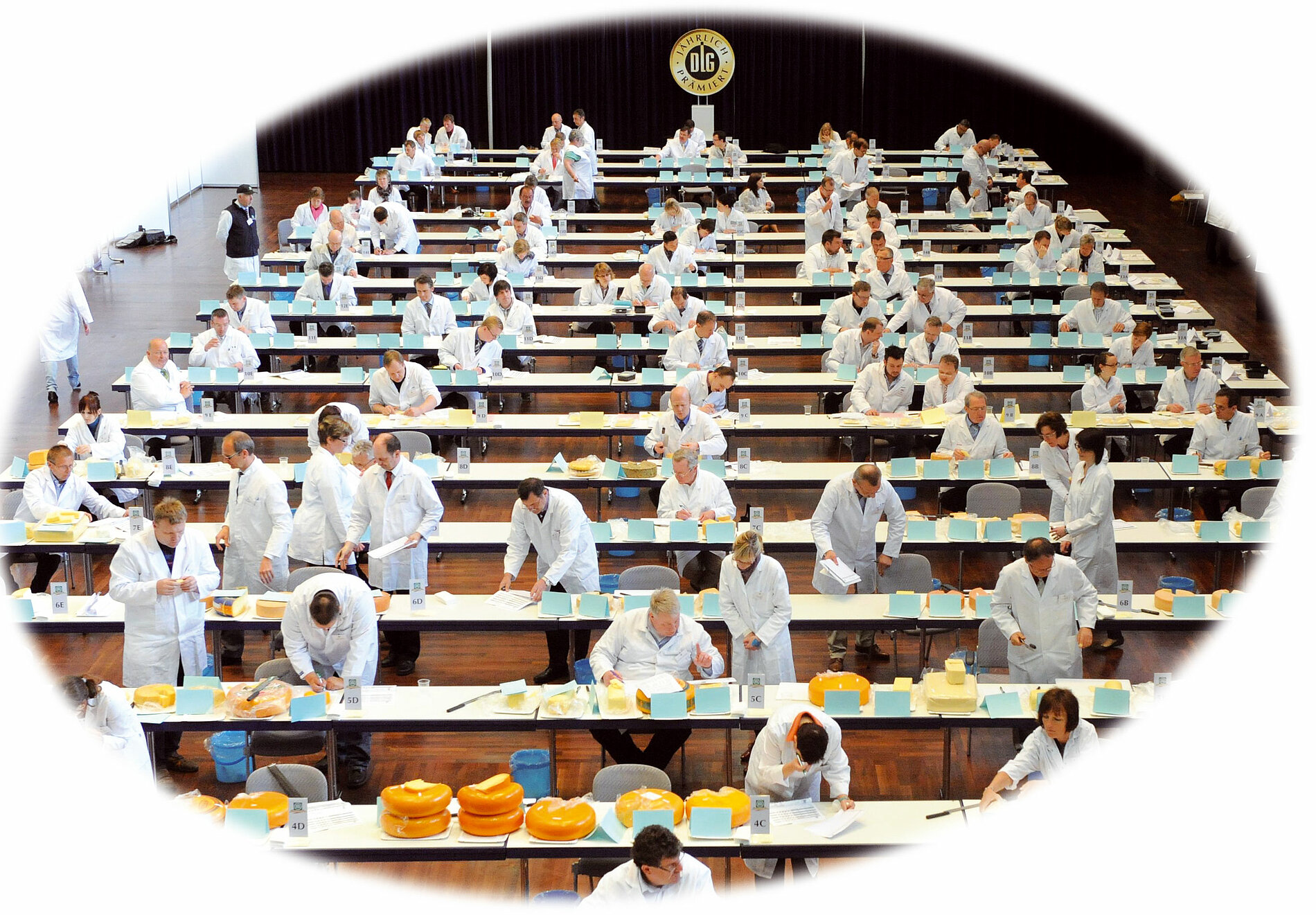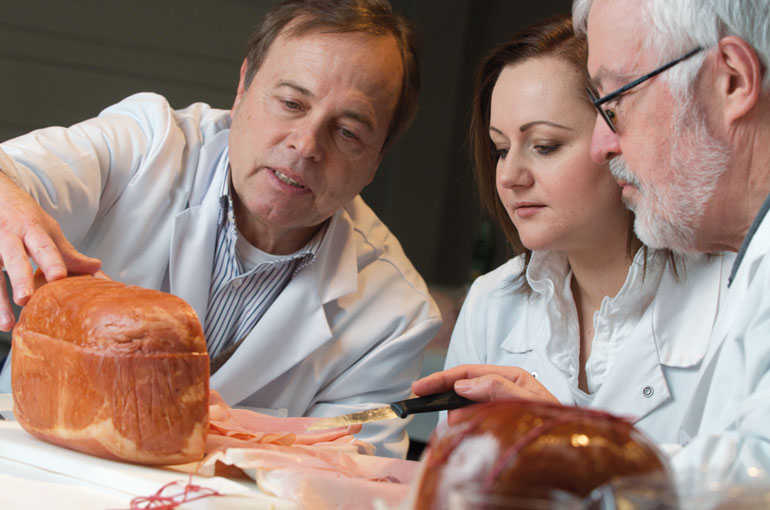Assessment of enjoyment value in DLG Quality Tests
DLG Expert report 10-2015
Author:
- Professor Emeritus Dr. Goetz Hildebrandt, Institute of Food Hygiene, Goetz.Hildebrandt@fu-berlin.de
- Jörg Jacob, Leipzig, H.JoergJacob@t-online.de
- Bianca Schneider-Häder, Elisabeth Hamacher, DLG e.V. - Competence Center Food Frankfurt/M., Germany, sensorik@DLG.org
- Britta Loewe-Stanienda, DLG Test Center Food, B.Loewe-Stanienda@DLG.org
Introduction
Since the first food test conducted in the year 1891, the DLG award system has achieved a high degree of recognition among consumers. This results in the obligation to face a critical public as regards both the theoretical basis and the practical implementation of DLG Quality Tests. The same questions are repeatedly raised in pertinent discussions, in particular regarding the sensory examination and assessment. These points are formulated and discussed below in separate thematic complexes. The individual sections are arranged in a logical sequence and build on each other.
Sensory assessment/tasting as neutral guidance for consumers
According to natural science criteria, foods serve both nutritional and enjoyment purposes. Whether a food can provide us with enjoyment depends largely on the attributes of appearance, consistency, odour and taste. Thanks to intensive inhouse and external monitoring, foods generally satisfy the requirements of product composition and product safety, but consumers cannot assume that they will also like the taste, or in other words that the enjoyment value of a food will satisfy their requirements. Official surveillance only steps in here in the event of substantial deviations, while minor failings remain unchallenged. The quality tests conducted by NGOs, magazines, TV broadcasters or consumer organizations admittedly often include a sensory test, but they are limited to just individual products. Accordingly, there is a lack of any instance that provides consumers with the essential objective information they need about the enjoyment value of a large number of food types from as many producers as possible and in this way support their purchasing decision. By combining an easily understandable award system with core competence in sensory testing, DLG as a longstanding, traditional test institute has taken on this public-serving task. At its annual International DLG Quality Tests, DLG tests processed foods from all areas of conventional production, as well as organic products and foods for the elderly.
Objectivity, expert knowledge and inner standard
Despite all efforts with electronic noses and tongues and other analytical apparatus, only humans are able to conduct an authentic and holistic assessment of enjoyment value on the basis of a sensory test. Accordingly the gathering, description and assessment of a sensory profile should be carried out by suitable test persons. In order to ensure the most neutral possible and at the same time proper findings and analysis, DLG uses the services of acknowledged experts. Such experts must not only be experienced specialists familiar with the theory and practice of sensory testing (= sensory assessors), but should also be distinguished by product-related expertise (= technical experts). Such skills are defined as profound knowledge about the production, properties and marketability of the tested products. As a DIN standard formulates, this should result in a representative and up-to-date internalized standard – largely acquired through professional experience, tuition and further training – regarding the prevailing opinion about the sensory quality of the foods to be tested. As a result of this “inner standard”, experts are able to make an objective comparison between standards of quality and their realization. The fact that the examination of foods for edibility by government inspection laboratories derives from the same principle, namely assessment based on a professionally grounded “inner standard”, confirms the scientific respectability of the DLG method.
Does it not run contrary to human, emotion-guided nature to demand absolute neutrality from an expert in the assessment of enjoyment value? The answer is “no”, for the ability to be objective results from the essential feature of our intelligence that enables us to inhibit personal impulses and adopt the perspective of others (known as the theory of mind). And nothing less than an application of human intelligence, namely culinary intelligence, is required for sensory expert opinions. Alongside the perception and consideration of usual consumption habits, neutrality also demands the willingness to leave oneself behind and where necessary to relativism one’s own opinion or even correct one’s personal “inner standard”.
Promoting the diversity of foods
In a free market economy, a certain variability of the sensory attributes within a food type is a feature of competition, for only distinguishing factors enable consumers to make choices geared to their own needs. That is why experts should suppress their own specific preferences when testing. Instead, their “inner standard” must take into account the complete “hedonic bandwidth” as standard. This reference value can be defined as the accurate overall picture of the entirety (cluster) of sound samples of a food type satisfying the prevailing opinion in all sensory properties. As the only true product for all consumers does not exist, a DLG expert for example will also never answer the question which of the two market leaders of caffeine-based soft drinks he would recommend to consumers on sensory grounds. If they do not show any measurable defects, both variants evidently satisfy the general type standard for such foods, and although they display sensory differences in the quality test, they are deemed to be of equal value. The same applies for the features “meltingly smooth” or “firm to the bite” as stand-alone attributes for milk chocolate, while bitter chocolate should not immediately melt in the mouth. Thus the suitability of test persons depends crucially on their ability to distinguish between desired diversity and undesirable deviation from the consumer expectation.
More than just a sensory assessment
A sensory assessment not only delivers information about the enjoyment value of a food. In addition other attributes can be captured without analytical input. For example, beyond determining the sensory profile, it is also possible to examine the labelling for legal compliance, the condition of the packaging and the plausibility of instructions for preparation at the same time. Furthermore, for certain food types accompanying obligatory laboratory tests are carried out. Independently of this, corresponding analyses are undertaken if any suspicion of harm to health or deception arises during the sensory testing of a sample. If this involves complicated processes, suitable contract partners are commissioned here.
According to the conditions for admission to tests, only products that satisfy the relevant national and EU provisions as well as the DLG test conditions may be submitted. Consequently the awards are always issued subject to reservations and in the event of infringements against the regulations they can be revoked.
Uniform rules for awarding DLG medals
The standard by which the quality of a food sample is measured at a DLG Quality Test is the overall picture (“inner standard”) of a product with rounded and harmonized appearance, consistency, odour and taste. Deviations in the sector of craft perfection, known as the hedonic bandwidth, are considered to be faults. Such orientation to negative deviations from the optimal quality standard is more concrete and more objective than attempts to assess a product partially or even exclusively via positive attributes (e.g. “attractive presentation”, “type-specific texture” or “tart-tangy aroma”).

Consumer expectations and their significance for the DLG Quality Test
The objectivity of the DLG Quality Tests is ensured by assigning experts as testers. Alongside their sensory capabilities, these persons are characterized by a both representative and up-to-date internalized standard regarding generally customary demands made of the enjoyment value of a food. Such a product- related ideal picture is largely acquired through professional experience, tuition and further training and covers the bandwidth of perfect products. By contrast with experts from the fields of production, trade, surveillance and academia, “normal consumers” do not possess this background knowledge. Instead they follow their own, subjective concepts and can therefore only be deployed for popularity testing where the market prospects of products are to be assessed with the help of large numbers of “testers”. However, even without the specific inclusion of untrained consumers in the DLG test, the focus is on the expectations of this group. For only an expert who is able to assess the preferences of customers in a representative fashion and orients his assessment to these deserves the title of expert.
Measures to secure the quality of actual testing
Voluntary tests such as the DLG Quality Tests can only be successful if both the test customers, in other words the producers submitting the samples, and the addressees, i.e. the consumers, trust the examination and scoring system. In order to achieve credibility, the organizational structures are subject to constant revision, the training and selection of testers is perfected, and the scientific foundations are adapted to new findings. As documentary evidence of these efforts, it has been possible to certify the DLG testing methodology in accordance with ISO and DIN. The training and appointment of suitable persons as certified DLG experts lies in the self-interest of many firms and examination establishments, including official surveillance bodies.
One quite essential organizational measure is the rendering anonymous of samples, i.e. the foods are tested without the testers knowing the producer, the brand or the price. Further key management elements include the use of standardized record sheets with defined fault attributes, instructions for testers and examination of alignment samples at the beginning of the event, the inspection of reserve samples in cases of doubt and supervision by test group leaders and test officers including an evaluation of testers. Furthermore, spot post-checks of products are conducted by contract laboratories in order to track down any possible special production batches. The fact that hardly any indications of tampering/manipulation are found here is plausible, as such deceptions require an incommensurately high outlay and moreover are quite likely to fail due to a lack of corresponding experience.While at the beginning of the DLG Quality Tests the individual professional experience of the experts alone was sufficient to legitimize their evaluations, modern sensory testing calls for back-up in the form of a sound scientific basis. A two-stage procedure consisting of an individual test and subsequent group consensus-finding was developed as an appropriate solution for a descriptive test with integrated assessment such as is required by the comparative quality tests.
Many DLG experts from the fields of science and academia, our own Sensory Committee, the organizing of scientific seminars and congresses and the award of research contracts ensure that this concept is kept under constant scrutiny.
Stand-alone features of the DLG Quality Test
Originally created to improve the quality of German agricultural products, the DLG Quality Tests have not only become increasingly popular among domestic producers, but are also becoming ever more significant outside Germany too. This international recognition is manifested on the one hand in the submission of samples by foreign producers, and on the other hand in the conduct of quality tests in the field, e.g. in the Czech Republic or Japan. Such success motivates imitators, mainly at a regional level and without certification by the organizer. The vast number of product competitions always uses the concept, the organizational principles and as far as possible also the co-participation of DLG experts. Even if isolated modifications are undertaken (assignment of lay testers or cup trophies instead of medals), there is no independent further development of the testing system. Only at DLG does a team of full-time staff engage in constant dialogue with a large number of honorary experts from the fields of business, food surveillance and research to ensure that new findings are incorporated promptly and in line with practice in the sensory quality tests. As a result of this consistent improvement, DLG will remain the standard for quality tests.
Further reading:
Hildebrandt, G., Jacob, J., Loewe-Stanienda, B., Oehlenschläger, J. und Schneider-Häder, B. (2012): Descriptive sensory analysis with integrated quality rating as a tool for quality testing of commercial food products. Journal of Food Safety and Food Quality 63 (5), 155-162



